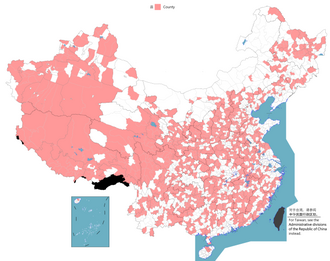Counties of China
This article includes a list of generalreferences,butit lacks sufficient correspondinginline citations.(January 2018) |
You can helpexpand this article with text translated fromthe corresponding articlein Chinese.(March 2023)Click [show] for important translation instructions.
|
| County Huyện Xiàn | |
|---|---|
| |
 | |
| Category | Third leveladministrative divisionof aunitary state |
| Location | People's Republic of China |
| Found in | Prefectures,Provinces |
| Number | 1,319 (1,307 controlled, 11 claimed) (as of 2023) |
| Government |
|
| Subdivisions | |
| County | |||||||||
|---|---|---|---|---|---|---|---|---|---|
| Chinese name | |||||||||
| Simplified Chinese | Huyện cấp hành chính khu | ||||||||
| Traditional Chinese | Huyện cấp hành chính khu | ||||||||
| |||||||||
| Alternative Chinese name | |||||||||
| Simplified Chinese | Huyện | ||||||||
| Traditional Chinese | Huyện | ||||||||
| |||||||||
| Tibetan name | |||||||||
| Tibetan | རྫོང་། (formerly tông in Chinese) | ||||||||
| |||||||||
| Zhuang name | |||||||||
| Zhuang | Yen | ||||||||
| Korean name | |||||||||
| Hangul | 현 | ||||||||
| |||||||||
| Mongolian name | |||||||||
| Mongolian Cyrillic | Шянь | ||||||||
| Mongolian script | ᠰᠢᠶᠠᠨ | ||||||||
| |||||||||
| Uyghur name | |||||||||
| Uyghur | ناھىيە | ||||||||
| |||||||||
| Manchu name | |||||||||
| Manchu script | ᡥᡳᠶᠠᠨ | ||||||||
| Möllendorff | hiyan | ||||||||
| Kazakh name | |||||||||
| Kazakh | اۋدان аудан audan | ||||||||
| Kyrgyz name | |||||||||
| Kyrgyz | وودان оодан oodan | ||||||||
| Administrative divisions of China |
|---|
|
History:before 1912,1912–49,1949–present Administrative division codes |
Counties(simplified Chinese:Huyện;traditional Chinese:Huyện;pinyin:Xiàn) are found in thethird levelof the administrative hierarchy inprovincesandautonomous regionsand the second level inmunicipalitiesandHainan,a level that is known as "county level"and also containsautonomous counties,county-level cities,banners,autonomous bannersandcity districts.There are 1,355 counties inmainland Chinaout of a total of 2,851 county-level divisions.
The termxianis sometimes translated as "district"or"prefecture"when put in the context ofChinese history.
History[edit]
Xianhave existed since theWarring States periodand were set up nationwide by theQin dynasty.[1][2]The number of counties inChina propergradually increased from dynasty to dynasty. AsQin Shi Huangreorganized the counties after his unification, there were about 1,000. Under the EasternHan dynasty,the number of counties increased to above 1,000. About 1400 existed when theSui dynastyabolished thecommanderylevel ( quận jùn), which was the level just above counties, and demoted some commanderies to counties. The current number ofcountiesmostly resembled that of the later years ofQing dynasty.Changes of location and names of counties inChinese historyhave been a major field of research in Chinese historical geography, especially from the 1960s to the 1980s.[citation needed]
In Imperial China, the county was a significant administrative unit because it marked the lowest level of the imperial bureaucratic structure;[citation needed]in other words, it was the lowest level that the government reached. Government below the county level was often undertaken through informal non-bureaucratic means, varying between dynasties. The head of a county was themagistrate,who oversaw both the day-to-day operations of the county as well as civil and criminal cases.
During the Republican period, counties were the second level administrative divisions of its provinces. After the Chinese Civil War, counties became subordinate to prefectural level cities while the previous structure is retained. The counties became directly governed by theExecutive Yuanafter the provinces became streamlined in 1998, but they were fully abolished in 2018.
Autonomous counties[edit]
Autonomous counties (Tự trị huyện;zìzhìxiàn) are a special class of counties inmainland Chinareserved for non-Han Chineseethnic minorities.Autonomous counties are found all over China, and are given, by law, more legislative power than regular counties.
There are 117 autonomous counties in mainland China.
Government[edit]
As theChinese Communist Party(CCP) is central to directing government policy in mainland China, every level of administrative division has a local CCP committee. A county's[clarification needed]is called thesecretary(Trung cộng huyện ủy thư ký), thede factohighest office of the county. Policies are carried out via thepeople's governmentof the county, and its head is called the county governor (Huyện trường). The governor is often also one of the deputy secretaries in the CCP Committee.
See also[edit]
- Counties of China— historical
- List of counties in the People's Republic of China
- List of county-level divisions of China
- History of the administrative divisions of China
- Attached county,a former sort ofxianin late Imperial China
- County (Taiwan)
References[edit]
Citations[edit]
- ^Hsu, Cho-yun (2012) [2006].China: A New Cultural History.Translated by Baker, Timothy D. Jr.; Duke, Michael S. Columbia University Press. p. 102.ISBN9780231159203.
- ^Goodman, David S.G., ed. (2015).Handbook of the Politics of China.Edward Elgar Publishing Limited. p. 159.ISBN9781782544364.
Sources[edit]
- Ch'u, T'ung-tsu(1962),Local Government in China under the Ch'ing,Cambridge, Massachusetts:Harvard University Press
